A sunny midwinter morning at Distillery Creek proved to be good for birding, in contrast to the previous dull, wet day when few birds were evident. (Full list at end of report).
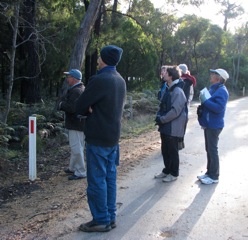
Start of the walk along the road – all photos courtesy of Ellinor Campbell
Many birds were busy in the leaf canopy, but the strong winds at that level made it very hard to locate them in the ever-moving foliage. We enjoyed hearing numbers of honeyeaters, particularly the Crescent Honeyeaters, which seemed as numerous as the ubiquitous New Holland Honeyeaters. It was a good learning environment to distinguish the range of calls of the Crescent HE, apart from their most well-known “egypt” call.
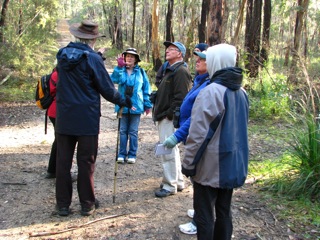
Fingerless gloves are good at this time of year!
Two types of cuckoos were heard but, even with some diligent looking, were not seen.

Where is that Cuckoo?
A Golden Whistler heard early in the walk along the road, finally came close enough when we were on the bush track for everyone to have a clear view of his glorious markings.
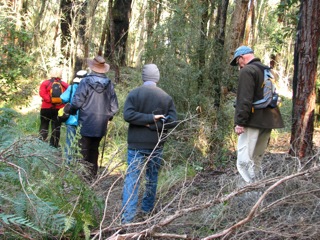
Now for the bush track

Look.. it’s a Golden Whistler
Towards the end of the main walk we were delighted to hear, then see, two Yellow-tailed Black Cockatoos languidly fly past, with one landing nearby so we could check if it had a red band around the eye, which is a characteristic of a male.

Our wonderful scribe
The highlight was a different LBB (Little Brown Bird) high up in a tree displaying its white underparts and flicking its wings and tail in an unusual way. Finally we saw a bit of a blush on its upper chest and, after much looking in an iPhone app. and a bird book, we came up with a diagnosis…a female Rose Robin, indeed a most unusual sighting.

What is that LBB? We’ll look in the book

How about the Iphone app?
At morning tea in the picnic ground we were entertained by a pair of Scarlet Robins. Two of us decided to walk back into town in the sun and see what else we could find.
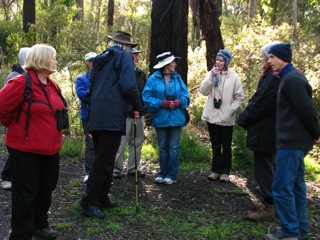
What now… who wants to walk back to town?
There were a range of water birds in the swampy areas in the paddocks near the Creek, and we had our only sighting of a raptor… a Nankeen Kestrel. The view out to sea from the lighthouse was really something, with the extreme winds turning the sea near the shore into a frothing cauldron of white.

Aireys Inlet beach
The high winds had brought some Shy Albatross closer to shore than usual, and were beautiful to see as they glided effortlessly over the waves. To the naked eye they disappeared from view when their upper body with black wings were toward the shore then appeared, as if by magic, as they turned and their white underparts caught the sun’s rays.


Can you see the Albatross?
The morning finished on a high note to the ringing sounds of Singing Honeyeaters and our most special of birds, the Rufous Bristlebird which is highlighted on the Angair mosaic.
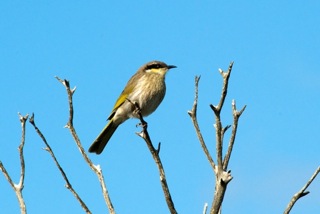
Singing Honeyeater
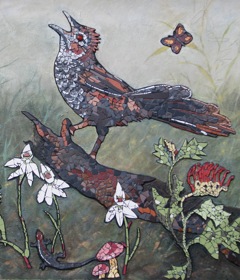
Rufous Bristlebird
Ellinor Campbell
Below are all the birds identified on this walk:
Distillery creek/Painkalac Creek & paddocks/Coastal Reserve Reserve/Ocean
- Black Swan
- Australian Wood Duck
- Grey Teal
- Shy Albatross
- Australasian Gannet
- Little Pied Cormorant
- Great Cormorant
- Eastern Great Egret
- White-faced Heron
- Nankeen Kestrel
- Masked Lapwing
- Yellow-tailed Black
- Sulphur-crested Cockatoo
- Crimson Rosella
- Shining Bronze Cuckoo
- Fan-tailed Cuckoo
- Laughing Kookaburra
- White-throated Treecreeper
- Superb Fairy-wren
- Rufous Bristlebird
- White-browed Scrubwren
- Brown Thornbill
- Eastern Spinebill
- Singing Honeyeater
- White-eared Honeyeater
- Red Wattlebird
- Crescent Honeyeater
- New Holland Honeyeater
- White-naped Honeyeater
- Golden Whistler
- Grey Shrike-thrush
- Australasian Magpie
- Pied Currawong
- Grey Currawong
- Grey Fantail
- Willy Wagtail
- Little Raven
- Magpie Lark
- Scarlet Robin
- Flame Robin
- Rose robin
- Eastern Yellow Robin
- Welcome Swallow
- Bassian Thrush
- Common Blackbird
- Common Starling